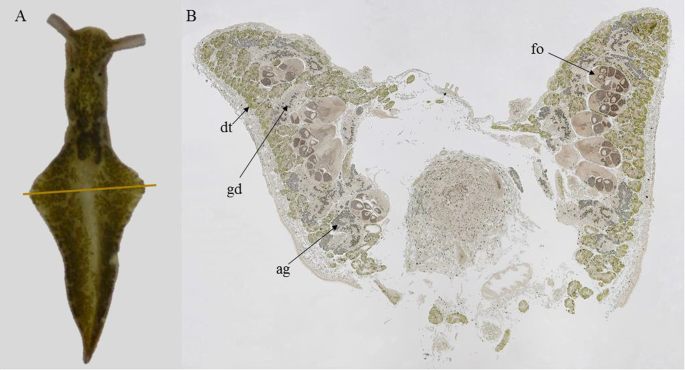
Rumpho, M. E., Dastoor, F. P., Manhart, J. R. & Lee, J. In The Structure and Function of Plastids (eds Robert R. Wise & J. Kenneth Hoober) 451-473 (Springer Netherlands, 2007).
Kawaguti, S. & Yamasu, T. Electron microscopy on the symbiosis between an elysioid gastropod and chloroplasts from a green alga. Biol. J. Okayama Univ. II, 57–64 (1965).
Hinde, R. & Smith, D. C. Persistence of Functional Chloroplasts in Elysia viridis (Opisthobranchia, Sacoglossa). Nat. N. Biol. 239, 30–31 (1972).
Trench, R. K. & Ohlhorst, S. The stability of chloroplasts from siphonaceous algae in symbiosis with sacoglossan molluscs. N. Phytol. 76, 99–109 (1976).
Mujer, C. V., Andrews, D. L., Manhart, J. R., Pierce, S. K. & Rumpho, M. E. Chloroplast genes are expressed during intracellular symbiotic association of Vaucheria litorea plastids with the sea slug Elysia chlorotica. PNAS 93, 12333–12338 (1996).
Cruz, S., Calado, R., Serôdio, J. & Cartaxana, P. Crawling leaves: Photosynthesis in sacoglossan sea slugs. J. Exp. Bot. 64, 3999–4009 (2013).
Händeler, K., Grzymbowski, Y. P., Krug, P. J. & Wägele, H. Functional chloroplasts in metazoan cells – a unique evolutionary strategy in animal life. Front. Zool. 6, 28 (2009).
Gustafson, D. E., Stoecker, D. K., Johnson, M. D., Van Heukelem, W. F. & Sneider, K. Cryptophyte algae are robbed of their organelles by the marine ciliate Mesodinium rubrum. Nature 405, 1049–1052 (2000).
Bernhard, J. M. & Bowser, S. S. Benthic foraminifera of dysoxic sediments: chloroplast sequestration and functional morphology. Earth-Sci. Rev. 46, 149–165 (1999).
Hansen, P. J. et al. Photoregulation in a Kleptochloroplastidic Dinoflagellate, Dinophysis acuta. Front. Microbiol. 7, 785 (2016).
Van Steenkiste, N. W. L. et al. A new case of kleptoplasty in animals: Marine flatworms steal functional plastids from diatoms. Sci. Adv. 5, eaaw4337 (2019).
Dorrell, R. G. & Howe, C. J. What makes a chloroplast? Reconstructing the establishment of photosynthetic symbioses. J. Cell Sci. 125, 1865–1875 (2012).
Cartaxana, P., Trampe, E., Kühl, M. & Cruz, S. Kleptoplast photosynthesis is nutritionally relevant in the sea slug Elysia viridis. Sci. Rep. 7, 7714 (2017).
Hinde, R. & Smith, D. C. The role of photosynthesis in the nutrition of the mollusc Elysia viridis. Biol. J. Linn. Soc. 7, 161–171 (1975).
Christa, G. et al. Plastid-bearing sea slugs fix CO2 in the light but do not require photosynthesis to survive. Proc. R. Soc. B Biol. Sci. 281, 20132493 (2014).
Kopp, C. et al. Subcellular investigation of photosynthesis-driven carbon assimilation in the symbiotic reef coral Pocillopora damicornis. mBio 6, e02299–02214 (2015).
LeKieffre, C. et al. Assimilation, translocation, and utilization of carbon between photosynthetic symbiotic dinoflagellates and their planktic foraminifera host. Mar. Biol. 165, 104 (2018).
Laetz, E. M. J., Moris, V. C., Moritz, L., Haubrich, A. N. & Wägele, H. Photosynthate accumulation in solar-powered sea slugs – starving slugs survive due to accumulated starch reserves. Front. Zool. 14, 4 (2017).
Laetz, E. M. J., Rühr, P. T., Bartolomaeus, T., Preisfeld, A. & Wägele, H. Examining the retention of functional kleptoplasts and digestive activity in sacoglossan sea slugs. Org. Div. Evol. 17, 87–99 (2017).
Trench, R. K., Boyle, J. E., Smith, D. C. & John Laker, H. The association between chloroplasts of Codium fragile and the mollusc Elysia viridis III. Movement of photosynthetically fixed 14C in tissues of intact living E. viridis and in Tridachia crispata. Proc. R. Soc. B Biol. Sci. 185, 453–464 (1974).
Trench, R. K., Greene, R. W. & Bystrom, B. G. Chloroplasts as functional organelles in animal tissues. J. Cell Biol. 42, 404–417 (1969).
Teugels, B., Bouillon, S., Veuger, B., Middelburg, J. J. & Koedam, N. Kleptoplasts mediate nitrogen acquisition in the sea slug Elysia viridis. Aquat. Biol. 4, 15–21 (2008).
Trench, R. K., Elizabeth, J. B., Smith, D. C. & John Laker, H. The association between chloroplasts of Codium fragile and the mollusc Elysia viridis II. Chloroplast ultrastructure and photosynthetic carbon fixation in E. viridis. Proc. R. Soc. B Biol. Sci. 184, 63–81 (1973).
Jensen, K. R. Anantomy of some Indo-Pacific Elysiidae (Opisthobranchia: Sacoglossa (=Ascoglossa)), with a discussion of the generic division and phylogeny J. Moll. Stud. 58, 257–296 (1992).
Klussmann-Kolb, A. Comparative investigation of the genital systems in the Opisthobranchia (Mollusca, Gastropoda) with special emphasis on the nidamental glandular system. Zoomorphology 120, 215–235 (2001).
Wägele, M. & Johnsen, G. Observations on the histology and photosynthetic performance of “solar-powered” opisthobranchs (Mollusca, Gastropoda, Opisthobranchia) containing symbiotic chloroplasts or zooxanthellae. Org. Div. Evol. 1, 193–210 (2001).
Wägele, H., Stemmer, K., Burghardt, I. & Händeler, K. Two new sacoglossan sea slug species (Opisthobranchia, Gastropoda): Ercolania annelyleorum sp. nov. (Limapontioidea) and Elysia asbecki sp. nov. (Plakobranchoidea), with notes on anatomy, histology and biology. Zootaxa, 1–28 (2010).
Brown, A. P., Slabas, A. R. & Rafferty, J. B. In Lipids in Photosynthesis: Essential and Regulatory Functions (eds Hajime Wada & Norio Murata) 11-34 (Springer Netherlands, 2009).
Kelly, J. R. & Scheibling, R. E. Fatty acids as dietary tracers in benthic food webs. Mar. Ecol. Prog. Ser. 446, 1–22 (2012).
Zhukova, N. V. Lipid classes and fatty acid composition of the tropical nudibranch mollusks Chromodoris sp. and Phyllidia coelestis. Lipids 42, 1169–1175 (2007).
Zhukova, N. V. Lipids and fatty acids of nudibranch mollusks: potential sources of bioactive compounds. Mar. drugs 12, 4578–4592 (2014).
da Costa, E. et al. Decoding bioactive polar lipid profile of the macroalgae Codium tomentosum from a sustainable IMTA system using a lipidomic approach. Algal. Research 12, 388–397 (2015).
Monroig, Ó., Tocher, R. D. & Navarro, C. J. Biosynthesis of polyunsaturated fatty acids in marine invertebrates: recent advances in molecular mechanisms. Mar. Drugs 11, 3998–4018 (2013).
Barnathan, G. Non-methylene-interrupted fatty acids from marine invertebrates: Occurrence, characterization and biological properties. Biochimie 91, 671–678 (2009).
Koo, A. J. K., Ohlrogge, J. B. & Pollard, M. On the export of fatty acids from the chloroplast. J. Biol. Chem. 279, 16101–16110 (2004).
Liu, B. & Benning, C. Lipid metabolism in microalgae distinguishes itself. Curr. Opin. Biotech. 24, 300–309 (2013).
Pelletreau, K. N., Weber, A. P. M., Weber, K. L. & Rumpho, M. E. Lipid accumulation during the establishment of kleptoplasty in Elysia chlorotica. PLoS One 9, e97477 (2014).
van Wijk, K. J. & Felix, K. Plastoglobuli: Plastid microcompartments with integrated functions in metabolism, plastid developmental transitions, and environmental adaptation. Ann. Rev. Plant. Biol. 68, 253–289 (2017).
Reiss, P. M., Pierce, S. K. & Bishop, S. H. Glutamate dehydrogenases from tissues of the ribbed mussel Modiolus demissus: ADP activation and possible physiological significance. J. Exp. Zool. 202, 253–257 (1977).
Sadok, S., Uglow, R. & Haswell, S. Glutamate dehydrogenase activity in Mytilus edulis: The effect of hyperammonia. Vie Milieu 51, 6 (2001).
Staehelin, L. A. & Moore, I. The Plant Golgi Apparatus: Structure, Functional Organization and Trafficking Mechanisms. Ann. Rev. Plant. Physiol. Plant Mol. Biol. 46, 261–288 (1995).
Harrison, P. J., Waters, R. E. & Taylor, F. J. R. A broad spectrum artificial sea water medium for coastal and open ocean phytoplankton. J. Phycol. 16, 28–35 (1980).
Meziane, T., d’ Agata, F. & Lee, S. Fate of mangrove organic matter along a subtropical estuary: small-scale exportation and contribution to the food of crab communities. Mar. Ecol. Prog. Ser. 312, 15–27 (2006).
Gladyshev, M. I., Sushchik, N. N., Kalachova, G. S. & Makhutova, O. N. Stable isotope composition of fatty acids in organisms of different trophic levels in the Yenisei river. PLoS One 7, e34059 (2012).
Source: Ecology - nature.com



